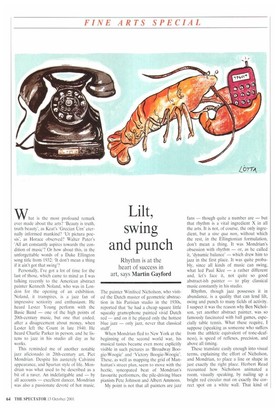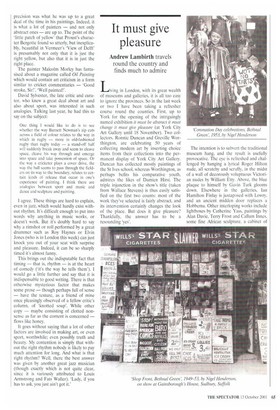Lilt, swing and punch
Rhythm is at the heart of success in art, says Martin Gayford What is the most profound remark ever made about the arts? 'Beauty is truth, truth beauty', as Keat's 'Grecian Urn' eternally informed mankind? -Ut pictura poesis', as Horace observed? Walter Pater's 'All art constantly aspires towards the condition of music'? Or how about this, in the unforgettable words of a Duke Ellington song title from 1932: 'It don't mean a thing jilt ain't got that swing'?
Personally, I've got a lot of time for the last of those, which came to mind as I was talking recently to the American abstract painter Kenneth Noland, who was in London for the opening of an exhibition. Noland, it transpires, is a jazz fan of impressive seniority and enthusiasm. He heard Lester Young perform with the Basic Band — one of the high points of 20th-century music, but one that ended, after a disagreement about money, when Lester left the Count in late 1940. He heard Charlie Parker in person, and he listens to jazz in his studio all day as he works.
This reminded me of another notable jazz aficionado in 20th-century art, Piet Mondrian. Despite his austerely Calvinist appearance, and Spartan style of life, Mondrian was what used to be described as a bit of a raver. An indefatigable and — by all accounts — excellent dancer. Mondrian was also a passionate devote of hot music. The painter Winifred Nicholson, who visited the Dutch master of geometric abstraction in his Parisian studio in the 1930s, reported that 'he had a cheap square little squeaky gramophone painted vivid Dutch red — and on it he played only the hottest blue jazz — only jazz, never that classical stuff'.
When Mondrian fled to New York at the beginning of the second world war, his musical tastes became even more explicitly visible in such pictures as 'Broadway Boogie-Woogie' and 'Victory Boogie-Woogie'. These, as well as mapping the grid of Manhattan's street plan, seem to move with the hectic, syncopated beat of Mondrian's favourite performers, the pile-driving blues pianists Pete Johnson and Albert Ammons.
My point is not that all painters are jazz
fans — though quite a number are — but that rhythm is a vital ingredient X in all the arts. It is not, of course, the only ingredient, but a sine qua non, without which the rest, in the Ellingtonian formulation, don't mean a thing. It was Mondrian's obsession with rhythm — or, as he called it, 'dynamic balance' — which drew him to jazz in the first place. It was quite probably, since all kinds of music can swing, what led Paul Klee — a rather different and, let's face it, not quite so good abstract-ish painter — to play classical music constantly in his studio.
Rhythm, though jazz possesses it in abundance, is a quality that can lend lilt, swing and punch to many fields of activity. I suspect it was the reason why Ben Nicholson, yet another abstract painter, was so famously fascinated with ball games, especially table tennis. What these require, I suppose (speaking as someone who suffers from the athletic equivalent of tone-deafness), is speed of reflexes, precision, and above all timing.
These translate easily enough into visual terms, explaining the effort of Nicholson, and Mondrian, to place a line or shape in just exactly the right place. Herbert Read recounted how Nicholson animated a room, visually speaking, by nailing up a bright red circular mat on exactly the correct spot on a white wall. That kind of precision was what he was up to a great deal of the time in his paintings. Indeed, it is what a lot of painters — and not only abstract ones — are up to, The point of the 'little patch of yellow' that Proust's character Bergotte found so utterly, but inexplicably, beautiful in Vermeer's 'View of Delft' is presumably not only that it is just the right yellow, but also that it is in just the right place.
The painter Malcolm Morley has fantasised about a magazine called Oil Painting which would contain art criticism in a form similar to cricket commentaries — 'Good stroke, Sir, `Well painted!'.
David Sylvester, the late critic and curator, who knew a great deal about art and also about sport, was interested in such analogies. Talking last year, he had this to say on the subject:
One thing I would like to do is to see whether the way Barnett Newman's zip cuts across a field of colour relates to the way in which in rugby — more in old-fashioned rugby than rugby today — a stand-off half will suddenly break away and seem to cleave space, cleave his way through and emerge into space and take possession of space. Or the way a cricketer plays a cover drive, the way the ball seems to pass through the fielders on its way to the boundary, relates to certain kinds of release that occur in one's experience of painting. I think there are analogies between sport and music and dance and sculpture and painting.
I agree. These things are hard to explain, even in jazz, which would hardly exist without rhythm. It's difficult enough to put into words why anything in music works, or doesn't work. But it's doubly hard to say why a rimshot or roll performed by a great drummer such as Roy Haynes or Elvin Jones (who is in London this week) can just knock you out of your seat with surprise and pleasure. Indeed, it can be so sharply timed it's almost funny.
This brings out the indisputable fact that timing — that is, rhythm — is at the heart of comedy (It's the way he tells them'). I would go a little further and say that it is indispensable to good writing. There is that otherwise mysterious factor that makes some prose — though perhaps full of sense — have the texture, as a friend of mine once pleasingly observed of a fellow critic's column, of 'knotted soup'. While other copy — maybe consisting of clotted nonsense as far as the content is concerned — flows like honey.
It goes without saying that a lot of other factors are involved in making art, or even sport, worthwhile; even possibly truth and beauty. My contention is simply that without the right rhythm nobody is likely to pay much attention for long. And what is that right rhythm? Well, there the best answer was given by another great jazz musician (though exactly which is not quite clear, since it is variously attributed to Louis Armstrong and Fats Waller). 'Lady, if you has to ask, you just ain't got it.'



























































































 Previous page
Previous page